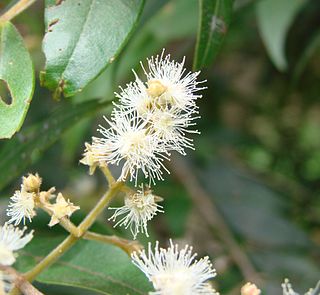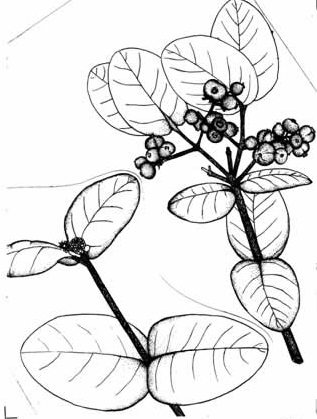
Myrtaceae, the myrtle family, is a family of dicotyledonous plants placed within the order Myrtales. Myrtle, pōhutukawa, bay rum tree, clove, guava, acca (feijoa), allspice, and eucalyptus are some notable members of this group. All species are woody, contain essential oils, and have flower parts in multiples of four or five. The leaves are evergreen, alternate to mostly opposite, simple, and usually entire. The flowers have a base number of five petals, though in several genera, the petals are minute or absent. The stamens are usually very conspicuous, brightly coloured, and numerous.

Myrcia is a genus of plants in the family Myrtaceae, containing about 765 species as of 2022. They are distributed in Central and South America, Mexico, and the Caribbean, with centers of diversity in the Brazilian Cerrado and Atlantic Forests ecoregions. Myrcia was first described as a genus in 1827.

Myrcia sintenisiana is a species of flowering plant in the family Myrtaceae. It is endemic to Puerto Rico, where it is limited to the Luquillo Mountains. It occurs in El Yunque National Forest in dwarf forest habitat on wet mountain ridges. Its common name is beruquillo.

Calothamnus rupestris, commonly known as mouse ears or granite net-bush, is a plant in the myrtle family, Myrtaceae and is endemic to the south-west of Western Australia. It is a shrub or small tree with short, stiff, prickly leaves and pink to red flowers in spring.

Leptospermum rupestre, commonly known as alpine tea-tree or prostrate tea-tree, is a flowering shrub in the myrtle family, Myrtaceae. It is endemic to Tasmania. In alpine areas it assumes a prostrate habit while in subalpine areas it appears as a large shrub.
Eucalyptus rupestris, commonly known as Prince Regent gum, is a species of small tree that is endemic to the Kimberley region of Western Australia. It has smooth bark, elliptical to egg-shaped or broadly lance-shaped adult leaves, flower buds in groups of seven, white flowers and cup-shaped to more or less cylindrical fruit.

Kunzea rupestris, the rocky kunzea, is a rare Australian plant in the myrtle family. There are some 20 known populations, all just north of Sydney, including Ku-ring-gai Chase National Park and Marramarra National Park. Threats to this species include track maintenance, invasive weeds, removal of rocks and sand, fire management and the cut flower industry.

Myrcia guianensis (pedra-ume-caá) is a species of plant in the genus Myrcia of the family Myrtaceae native to South America.
Myrcia crassa is a species of plant in the family Myrtaceae. It is endemic to the municipality of Santa Teresa, Espírito Santo, Brazil, where its habitat is fragmented and declining due to deforestation. The tree was first described in 2010 and grows to between 1.5 and 18 metres tall.
Myrcia mucugensis is a species of plant in the family Myrtaceae. It is endemic to Campos rupestres habitats in central Bahia, Brazil, 800 to 1000 metres above sea level. The shrub was first described in 2010 and grows to between 1.5 and 2 metres tall, with 2mm diameter fruits.
Myrcia pseudospectabilis is a species of plant in the family Myrtaceae. It is endemic to coastal rainforest habitats in southern Bahia, Brazil. The tree was first described in 2010, grows to between 1 and 6 metres tall, and produces purple or black fruits between 10 and 12mm in diameter.
Myrcia tetraphylla is a species of plant in the family Myrtaceae. It is endemic to coastal rainforest habitats in southern Bahia, Brazil. The tree was first described in 2010, grows to between 2 and 8 metres tall, and produces purple fruits between 15 and 22mm in diameter.
Plinia rivularis, commonly known as yva poroity, jaboticabarana, jabúriti, guapuriti, cambucá peixoto, jabuticaba de cacho, or piuna is a species of plant in the family Myrtaceae.
Myrciaria alta is a species of plant in the family Myrtaceae, endemic to Espírito Santo, Brazil. It was first described in 2019 and it is closely related to Myrciaria glomerata.
Myrciaria cambuca, named after its common name cambucá, is a species of plant in the family Myrtaceae. First described in 2019, it is a small shrub with reddish fruit, and was previously misidentified as Myrciaria ferruginea.
Myrcia ascendens is a species of plant in the family Myrtaceae, endemic to Bahia in north-east Brazil, and first described in 2015.
Myrcia attenuata is a species of plant in the family Myrtaceae, endemic to French Guiana, and first described in 2015.
Myrcia costeira is a species of plant in the family Myrtaceae, endemic to the south and south-east of Brazil, and first described in 2015.
Myrcia subterminalis is a species of plant in the family Myrtaceae, endemic to the east of Brazil, and first described in 2015.
Metrosideros tabwemasanaensis is species of plant in the family Myrtaceae. It is a tree endemic to Mount Tabwemasana on the island of Espiritu Santo in Vanuatu.






